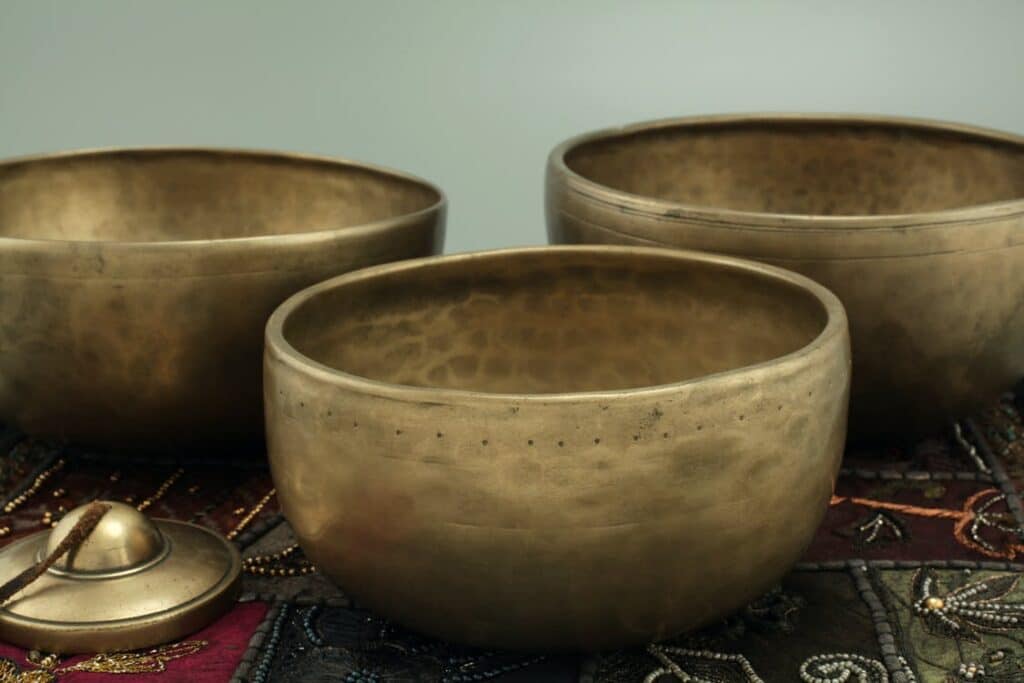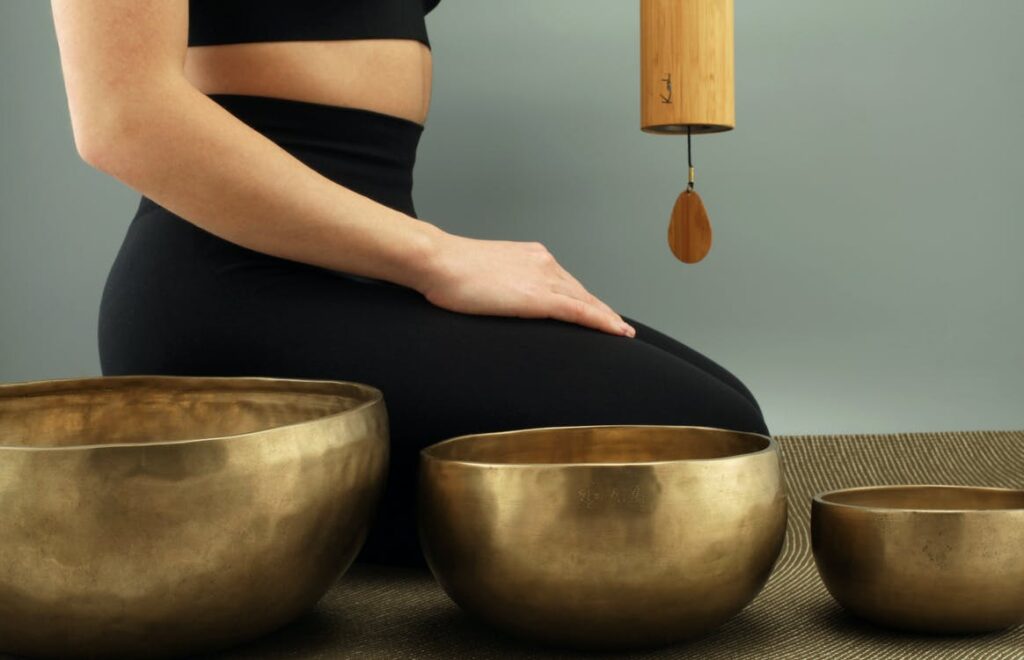Are you finding that your mind is often sifting through dozens of thoughts simultaneously, wreaking havoc on your tranquility? Then you’re just like me.
I’m a longtime meditator, and like millions of other people, I often rely on smartphone apps to time my sessions. They even offer a variety of soothing voices and sounds that quickly calm me down in a meditative state.
You have probably heard that famous “ding” sound a million times, inviting you to close your eyes and peek “inside.”

But only when you hear the full sound potential of singing bowls live, it will become clear to you that all the sounds produced by the application can’t be matched against the simple, but profound beauty of the simple “ding”.
Do you want to hear a secret? You don’t need to go to yoga studios to find those sounds. You can create them yourself, using only your hand and a deep metal or crystal bowl.
Yes, you can use singing sound bowls to create sounds that effortlessly calm the mind and lull you into a relaxed state. Who doesn’t want that? But what is a singing bowl?
What is a Tibetan singing bowl?
A singing bowl vibrates when played to produce a rich and deep tone. It is also known as crystal singing bowls or Tibetan singing bowls, depending on the material from which they are made.
These instruments are designed to be played by hitting them or swirling them with a mallet called “Pudja” that accompanies them and emits deep, vibrant timbres and musical forms. The Tibetan singing bowl is a very simple and ancient instrument.
They first appeared around 4000 BC in China or India. Their nature and use are closely related to the appearance of yoga. Meditators wanted an instrument that could “shock” them into stopping their thinking process.
But, they also wanted that shock to be comfortable at the same time. Thus, helping them to step into a state of relaxation easily. Singing bowls were originally made of various metals, such as mercury, lead, silver, metal alloy, iron, gold, and alloy of copper, and were all handmade.
Buddhist monks have long used Tibetan cups and metal bowls for singing in the practice of meditation. But their benefits were discovered by the rest of the world only in the 1970s when they were first introduced to the West. And only in the 2000s did science begin to be interested in them.
The mechanism of the singing bowl
Explaining why and how singing bowls work is very simple. They produce a vibration that is pleasant to the human nervous system. The vibration sounds “natural,” but due to the unique intensity of sound, it instantly brings the mind into a state of complete and undivided attention.
The development of your attention is the real benefit modern singing bowls offer to your state of being and spiritual practice. In a state of alert and relaxed attention, the nervous system is in complete relaxation because it is not burdened with thoughts. All of our attention is on our presence.
The singing bowls produce different vibrations and variations of the famous “ding” sound. The vibration of this sound is very close to the vibration produced by the chant of the word “AUM.”
Explaining why and how singing bowls work is very simple. They produce a vibration that is pleasant to the human nervous system. The vibration sounds “natural,” but due to the unique intensity of sound, it instantly brings the mind into a state of complete and undivided attention.
The development of your attention is the real benefit modern singing bowls offer to your state of being and spiritual practice. In a state of alert and relaxed attention, the nervous system is in complete relaxation because it is not burdened with thoughts. All of our attention is on our presence.
The singing bowls produce different vibrations and variations of the famous “ding” sound. The vibration of this sound is very close to the vibration produced by the chant of the word “AUM.”
The vibration variation can be quite different; it all depends on the singing bowl’s shape, size, and material. This difference in vibrations is most important in the so-called “sound baths” used as a sound treatment method by singing bowls.
You should know that adding water changes the frequency of singing bowls, and creates a more profound, longer-lasting resonance. Using water-filled singing bowls can create additional tones used for meditation or sound therapy.
A singing bowl can be used in two ways: through a healing treatment of a sound bath and individually in meditation with singing bowls.
- The healing treatment method with the help of a sound bath works by lying in a room where singing bowls of different sizes and shapes are arranged, filled with water, or empty. The guide will use “pujas” to strike the bowls to produce sound waves and vibrations. Sometimes this treatment is accompanied by guided meditation.
- Individual meditation with singing bowls has a unique functioning principle but with different variations. While meditating, gently tap the sides of the bowl to produce gentle sounds and vibrations that you can focus on.
What is the impact of Tibetan singing bowls?
Various claims about the physical healing powers of singing bowls can be found online. Some of them are exaggerated, as many things are if you scour the internet deep enough.
But, indeed, there are numerous beneficial effects to playing a singing Tibetan bowl. They have the power to cure (certain) illnesses and improve overall well-being. They can target specific problems you may be facing, both physically and mentally.

If you’re still wondering whether they work, then science is here to persuade you. Some scientific studies claim that singing bowl therapy can help cleanse the chakras, others that it can reduce pain and even help in recovering from cancer, that it can improve blood pressure and the respiratory rate, etc.
If some of these claims are disputed, it’s almost universally agreed that sound therapy improves sleep, promotes relaxation, and helps in managing our emotions. Try it, and you’ll see for yourself.
Do sound bowls work?
Some of these claims I have personally found to be true. But, undoubtedly the biggest benefit of singing bowls is that the unique vibration they produce confuses the “monkey mind”. That’s one of its most important benefits, and a prerequisite for successful and good meditation.
Of course, continuous individual meditation brings with it several potential benefits, both physical and psychological.
Tibetan bowls lies in the spiritual elemented by Tibetan bowls lies in the spiritual element. In calming the mind and establishing divine attention.
Perhaps the greatest benefit of meditation with the help of these sound bowls will be found by those people that are just entering the world of meditation or have not yet found the meditation that works for them.
The bowls can also help with more serious issues. According to Tamara Goldsby from the University of California, this type of meditation can immensely help people who have severe anxiety disorders or depression, and greatly aid one’s physical health.
Tips for buying a Tibetan singing bowl
Anyone can use a singing bowl, regardless of experience in meditation. If you are interested and want to start a new journey in the world of singing bowls, you must first acquire a quality singing bowl. However, as the bowls differ in the shape and material from which they are made (of course, first look to buy a bowl that is ethically made and delivered), my warm recommendation is to first visit one or more sound bath treatments.
There, you will not only get to know the nature of sound, but at the same time, you will develop an intuitive picture of which sound suits you best.
The next step is to buy the dish that sounds most relevant to you. This process is very intuitive and you do not need to think much or “overthink” about it. Just indulge your intuition and let your internal resonance choose its appropriate external resonance.
How to play a singing bowl?
Then you need training on how to use the dishes. You can easily find such training online (this video is a fantastic doorway to starting your singing bowl and sound healing treatments journey). Of course, you will need practice. And, don’t forget to clean the bowls once in a while, lest they get rusty, which can influence the sound vibrations coming out when you use one.
Sound meditation is a wonderful and extremely powerful way to enter a state of calm. If you’re thinking of introducing creative patterns to your meditations or yoga practice, then you can’t go wrong with singing bowls. Don’t do any intensive work after a session, rest a bit, and then continue with your day.
Regardless of how you use them, in sound baths or private meditation, the physical healing effects on the body and mind coming from that beautiful sound won’t escape you. If you’re wondering if there are some side effects from using them, don’t fret about it. Singing bowls are harmless, and can only do good to your emotional and psychological state.
What to expect from sound therapy?
When playing with sound bowls, it’s crucial to be patient to extract the amazing benefits of using them. Don’t expect your “monkey mind” to quiet overnight. But, using one over a longer period will not only quiet it. It will eventually make it your friend, not your enemy.
In the end, sound healing is a fantastic tool to bring you into a state of complete relaxation. You’ll forget about stress momentarily, and lull yourself into a meditative state that will keep you going for days afterward. So, what are you waiting for?
Want more articles about meditation? Check out our main home page!




